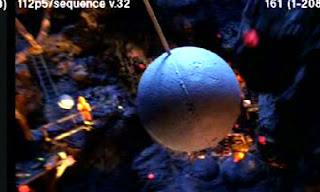Here’s visual effects wizard Wesley Sewell holding up two lighting reference balls during live action plate photography for the movie “Kingdom of Heaven.”
The purpose of those balls is to record the sources and distribution of lighting in the scene so that later on, the visual effects team can match the virtual lighting of the CGI elements that will be added to the shot.
Why do they need those balls to know the lighting? Isn't it obvious by looking at the lighting on Sewell’s face? There’s a strong, warm, low light source from off to the left somewhere.
But the mirror ball (also called a “light probe”) shows more. You can see that there are some thin high clouds near the sun diffusing the light just a bit, and the ground is a warm dirt color. Those factors change the effect of light appreciably.
 This shot is from the special effects company WETA Workshops’s model and miniature department. It’s a still frame from a test video sequence of a matte gray ball being “flown” through a miniature set of the catacombs of Orthanc in Lord of the Rings.
This shot is from the special effects company WETA Workshops’s model and miniature department. It’s a still frame from a test video sequence of a matte gray ball being “flown” through a miniature set of the catacombs of Orthanc in Lord of the Rings. In the frame at left, the ball is lit by a blue light from above, and a weaker orange light from below. During the test video, the lighting changed throughout the course of the fly-through. If you wanted to animate a digital creature flying into those caverns, the forms of the creature would have to respond to the same lights that are lighting the gray ball. Digital lighters can unwrap the data from the gray ball or the mirror ball into a spherical environment map.
Although I don’t use digital tools in my work, I sometimes adopt this trick when I photograph maquettes, because it makes it easier for me to reconstruct the pattern of light later on when I’m compositing various elements in the studio. This silver ball (an upended Christmas tree ornament) sits on a piece of kneaded eraser. It shows the illuminated wall on the left, the skylights and fluorescent lights on the ceiling, the greenish window light, and the sharp low spotlight. All these lights affect the way the forms are lit.
Here's another studio shot. This time there's no sharp spotlight; just the skylights and window light, and now my hands are a warm source of light bouncing into the shadows.
The main point here is that lighting is more complicated than just "light and shadow." In every real-world situation, there are multiple light sources, each with different qualities of softness, directionality, color temperature, and intensity. Whether you use reference balls or not, the more aware you are of those light sources, the more convincingly you can paint or render each of the forms in your scene.
By the way, thanks for all your really helpful comments on yesterday's post about art instruction videos. I'll be reading all of them carefully --ALL of them-- before I put my video together.
By the way, thanks for all your really helpful comments on yesterday's post about art instruction videos. I'll be reading all of them carefully --ALL of them-- before I put my video together.
LINKS FOR MORE INFO
Kingdom of Heaven (movie)
Lord of the Rings fan site










5 comments:
I love this post and look forward to re-reading it. This is an example of why I return to Gurney Journey several times a day: not only to learn more about what I'm interested in, but also to learn about things that I never realized I was interested in!
Fasciniating...
How funny, I was just flipping through Imaginative Realism and I believe there is one of these located on the bottom on page 86.
Pretty interesting stuff.
whoah, thanks for this extremely helpful post! I can only second Tom. I'm currently trying to teach myself without the help of art school and never had I imagined to search for reference ball...
Really great tip! Thanks for sharing!
Thanks for this great post, James. Great tip too. Having work in the VFX industry but in animation, I have always wondered about those spheres. I know our lighters use them and they can get the CG objects and creatures lit seamlessly into the film plates. :)
Post a Comment